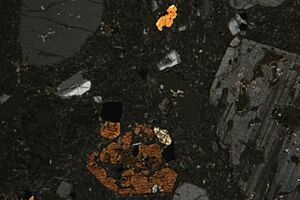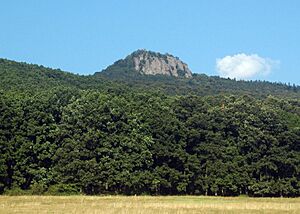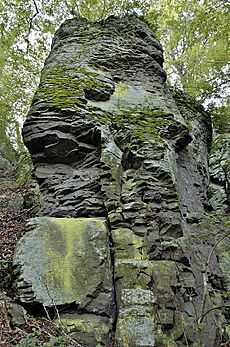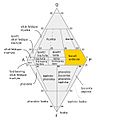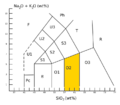Andesite facts for kids
| Igneous rock | |
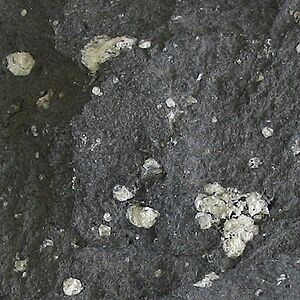
A sample of andesite (dark groundmass) with amygdaloidal vesicles filled with zeolite. Diameter of view is 8 cm.
|
|
| Composition | |
|---|---|
| Primary | Intermediate: plagioclase (often andesine) and pyroxene or hornblende |
| Secondary | Magnetites, biotite, sphene, and quartz |
Andesite is a type of volcanic rock that forms when lava cools quickly on Earth's surface. It has a medium amount of a mineral called silica, placing it between basalt (which has less silica) and rhyolite (which has more). Andesite can have very tiny crystals, or a mix of tiny and larger crystals. It is mostly made of plagioclase feldspar, along with other minerals like pyroxene or hornblende.
This rock is like the outdoor version of diorite, a similar rock that forms deep underground. Andesite is very common in places where Earth's tectonic plates meet and one slides under another. This process, called subduction, often creates chains of volcanoes known as island arcs. Much of Earth's continental crust is made of rock similar to andesite. Interestingly, andesite has also been found on Mars!
The name andesite comes from the Andes mountain range in South America. This is where the rock was first identified in large amounts by a scientist named Christian Leopold von Buch in 1826.
Contents
What is Andesite?
Andesite is a volcanic rock that forms from cooled lava. It usually has a fine-grained texture, meaning its crystals are too small to see without a microscope. Sometimes, it can also be porphyritic, which means it has larger crystals (called phenocrysts) mixed in with the tiny ones.
This rock has a medium amount of silica, which is a common mineral in Earth's crust. It also has low amounts of certain alkali metals. To be called andesite, at least 65% of its feldspar minerals must be plagioclase. It also contains less than 20% quartz and 10% feldspathoid.
Andesite is typically light to dark gray. Its color comes from minerals like hornblende or pyroxene. It can be hard to tell darker andesite apart from basalt, but andesite usually looks a bit lighter.
The plagioclase in andesite is often a type called andesine. Other minerals like augite, pigeonite, or orthopyroxene can also be found. Tiny amounts of minerals like magnetite, zircon, apatite, ilmenite, biotite, and garnet are common too.
Andesite often has larger crystals (phenocrysts) floating in a background of much smaller crystals. These larger crystals formed first, deep inside the Earth, before the rock erupted. Phenocrysts of pyroxene or hornblende are also common. These minerals have higher melting temperatures, so they are the first to form solid crystals from the molten rock. If hornblende is the most noticeable large crystal, for example, the rock is called a hornblende andesite.
Andesite and Volcanoes
Andesite lava is quite thick, like very stiff peanut butter. Because it's so thick, andesitic lava often leads to explosive volcanic eruptions. These eruptions can create rocks like tuff (made of ash) and agglomerate (made of larger rock fragments).
Instead of forming wide, flat shield volcanoes like basalt lava does, andesite lava tends to build tall, cone-shaped volcanoes. These are known as composite volcanoes or stratovolcanoes.
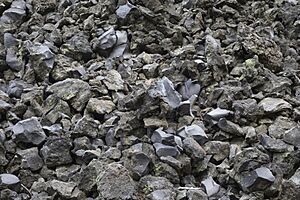
Andesite lava often forms "block lava flows." In these flows, the surface breaks into rough, angular blocks as it cools. The hot, molten lava underneath keeps flowing, pushing these blocks along. Block lava flows move much more slowly and are thicker than other types of lava flows.
Where Does Andesite Come From?
Andesite is especially common where Earth's tectonic plates crash into each other. In these areas, one plate slides beneath another in a process called subduction. This often creates chains of volcanoes in the ocean, known as island arcs. Geologists even noticed a special "andesite line" in the Pacific Ocean, showing where this rock is found.
When an oceanic plate slides down into the Earth, it carries water and other materials deep into the mantle (the layer below the crust). This water helps the rocks in the mantle to melt more easily, forming magma. This magma starts out similar to basalt. As it rises, it picks up special elements from the sinking plate.
This basaltic magma then changes as it rises towards the surface. It can become andesite through several processes, including fractional crystallization, mixing with other magmas, or melting parts of the Earth's crust.
How Magma Changes to Andesite
Intermediate volcanic rocks like andesite are created in a few different ways:
Crystals Sinking Down
When basaltic magma cools, certain minerals like olivine and amphibole crystallize first. These heavier minerals sink to the bottom of the magma chamber. This process removes them from the magma. The remaining magma then has more silica, gradually changing its composition towards andesite. If this process continues, the magma can even become rhyolite. This is why you often find basalt, andesite, and rhyolite together in volcanic areas.
Melting Other Rocks
Hot basaltic magma rising from the mantle can get stuck beneath the Earth's crust or push its way into it. This very hot magma can melt some of the surrounding crustal rock. When this happens, the melted crustal rock mixes with the basalt, changing its overall composition towards andesite.
Magma Mixing Together
Sometimes, different types of magma collect in underground chambers. Over time, magma in these chambers can become more silica-rich, like dacite or rhyolite. If new, hot basaltic magma enters these chambers and mixes with the older, more silica-rich magma, the result can be andesite. Scientists can see evidence of this mixing when they find crystals in the rock that don't quite match the rest of the magma they formed in.
Special Mantle Melting
A special type of andesite, called boninite, can form directly from the mantle. This happens when the mantle rock is changed by fluids that come from the subducting plate.
Famous Structures Made of Andesite
Andesite has been used for building for a very long time because it is strong and durable. Here are some famous structures made with this rock:
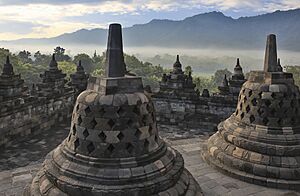
- Borobudur in Java, Indonesia, a large Buddhist temple.
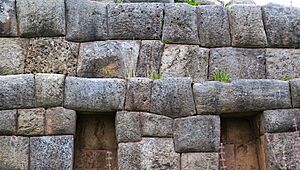
- Sacsayhuamán citadel in Peru, an ancient Inca fortress.
- Gate of the Sun in Bolivia, a large stone archway.
- Templo Mayor ruins and other historic buildings in Mexico City. These were built using andesite and a similar rock called Tezontle.
Andesite Beyond Earth
Andesite isn't just found on Earth! In 2009, scientists found andesite in two meteorites that were discovered in Antarctica. This shows that andesite can form in space too.
Along with basalt, andesite is a part of the Martian crust. Also, the presence of distinctive steep-sided domes on Venus suggests that andesite might have erupted there from large magma chambers.
Images for kids
See also


